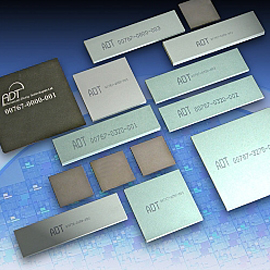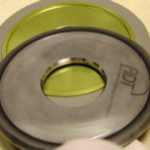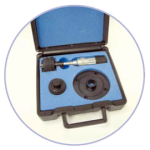Dressing Boards
DRESSING BOARD

ADT offers a wide range of Dressing Boards for different applications.
You can choose from different abrasives, mesh sizes, and dimensions to fit your needs.
Dressing = Exposing diamonds and releasing partially embedded diamonds


Diamonds not exposed Diamonds exposed after dressing
INTRODUCTION TO DRESSING
By Gideon Levinson, Senior Dicing Blades R&D Specialist
Why Dressing?
Diamond dicing blades are made of different binders: hard electroformed nickel, medium hard metal sintered, and soft phenolic resins.
All those blade binders have diamond grits homogenously dispersed in the blade matrix, and they are made with many different grit sizes, depending on the application material type and thickness. Each diamond particle acts in the dicing process like a single cutting tool and needs to be well-exposed in order to freely penetrate into the substrate material.
A well-exposed diamond is always required to minimize loads during the dicing and to maintain a free & low-temperature dicing process. Poor diamond exposure will result in high loads and poor cut quality (see the sketch).
Almost all blades are factory edge-grounded. The O.D. grinding is rounding the O.D., flattening the blade edge, and to some extent also exposing the diamonds.
However, blades need to be further dressed on-site before the dicing process and in some cases during the dicing process for the following reasons:
New Blades:
• Improving concentricity of the blade edge to spindle rotation
• Exposing the diamonds on the blade edge
• Machining off lost diamonds
• “Warming up” the blade (metallurgically) before penetrating into the production
• Substrate material
• In some applications – shaping/flattening the blade edge
Online Dressing during the Dicing Process:
• Cleaning powder residue to expose the diamonds
• Machining of blade binder to better expose new sharp diamonds
• Reshaping the blade edge.
Dressing Board Options Per Application and Blade Type
ADT offers a wide range of different dressing boards for different applications.
The most common blades requiring dressing are the nickel electroformed and metal sintered blades. Those binders are hard and require a machining media to machine off the blade binder and expose the diamonds well.
A large variety of different silicon carbide dressing boards is available, in different mesh sizes and geometry sizes, to fit many various applications.
Resinoid blades in most cases do not require special dressing as they wear fast and actually are self-re-sharpening type blades. However, the blade edge is important for some applications and requires a flat edge during the dicing. Eventually, this flat edge is lost due to coolant issues, thick and loading materials, and other related issues.
To reshape and perfect the blade edge to a flat edge, ADT developed a unique flat nickel electroformed dressing board that is available in a few diamond grits and different geometries.

To demonstrate the performance of these unique dressing boards and processes, see the micrographs below. The left micrograph demonstrates a blade edge that lost its shape during dicing, and the right micrograph demonstrates the same blade after using the ADT special nickel/diamond dressing board following dressing on the dress station.

During the years, ADT accumulated vast experience in different dicing processes for a large variety of applications. The ADT engineering team is available for tailor-made dressing procedures including dressing optimizations, which can be done in-house or at customer sites.
ADT dressing boards fit the dressing station which is optional for ADT 7100, 7200 & 7900 dicing systems. This option was developed by the ADT engineering team based on market needs and is a real help for many demanding applications.
See the dressing station description below.
Dressing Station
The 7100, 7200 & 7900 dicing saws have an option for online dressing station. The dressing station option is fully integrated into the dicing saw software package, and all dressing process parameters may be pre-defined along with the frequencies at which the blade is dressed.
Advantages:
• Dressing of new blades
• Periodic cleaning of blades from accumulated build-up
• Flattening the blade edge if needed
• Reducing operator intervention



